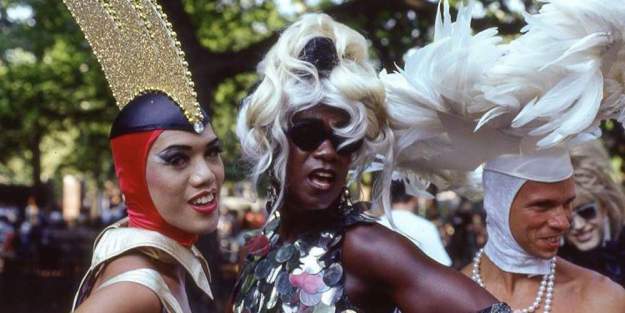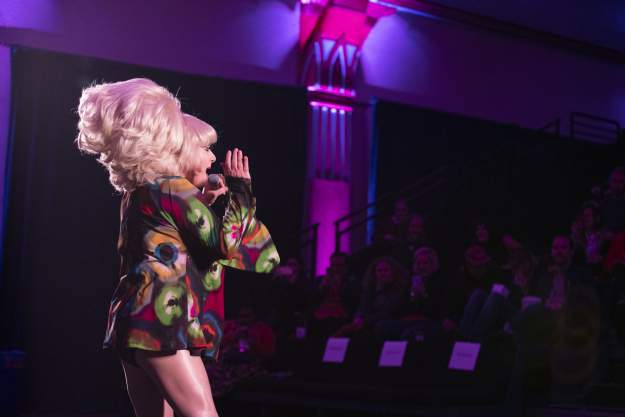Since 1984, the illustrious, legendary, pig in a wig—Lady Bunny—has been part of a drag movement that has left an impact in the way the masses perceive and interact with the art of drag. Wigstock, a gathering of drag queens, drag aficionados, spectators, and closet cases, celebrates its 35th anniversary this year. A revolution that began in New York City, Wigstock has been a stage for some of the greatest drag performers we know today including RuPaul, Coco Peru, Jackie Beat, Joey Arias, Lypsinka, as well as musical powerhouses like Deee-Lite, Crystal Waters, CeCe Peniston, Debby Harry, and Boy George!
It was a time before RuPaul’s Drag Race had even been flickered into the minds of what pop culture now understands to be the only way to be a successful drag queen. It was an alternative recourse for the weirdos, the outcasts, the marginalized, to turn up the music and celebrate diversity in its purest form. For Lady Bunny, this took her through the first years of her career as a drag queen when she was a go go dancer for the infamous Pyramid Club of New York.
To celebrate the milestone of LGBTQ+ history, the Red Bull Music Festival held a special screening of the Wigstock documentary from 1995 where we see the festival at one of its highest moments 10 years after it began. Prior to the documentary, Lady Bunny reminded the crowd why she is still a force to be reckoned with as she performed two of her original numbers.
Lady Bunny then participated in a Q&A with some never before seen footage from the 80s and 90s featuring Lady Bunny and her posse of drag lovers that included RuPaul. Archived short films and videos by Tom Rubnitz and Ned Sullivan set a foundation for the very inspirational conversation with Bunny.
East Hollywood’s Ukranian Culture Center continuously burst into laughter as Lady Bunny took us down memory lane. Other stories of struggle and darkness equally elevated Lady Bunny as a beacon of LGBTQ+ history where she describes a time when the fear of the HIV/AIDS crisis magnetized the LGBTQ+ community to bind together as one—sans labels or differences—mentioning that it is that type of camaraderie that the LGBTQ+ community is lacking today.
After the presentation, I had a great time sitting down with Lady Bunion and getting deep inside her wig about some things that inspired me from the program.
What really inspired you to start doing drag?
There are drag queens who live as men and identify as men, completely, so that when the drag is off—they’re men. As soon as the drag comes off, they’re men. Then there are other drag queens, like me, that realize that even though I don’t walk around throughout the day with this wig on to the supermarket, that we are doing drag not only to earn money, but we are expressing something that we feel is feminine in ourselves. Not only do we do it as a job but we do it because we look in the mirror and wonder “I wonder if your eyes would look further apart if you applied your mascara this way.” And we try different silhouettes and turbans. I’m from the South so I’ve been a man of the towel most of my life. It’s one thing you do when you don’t have a wig because you’ve seen your sister and mother do it. So you can see what your face would look like when you use something that approximated a wig.
When was Lady Bunny officially born?
In Atlanta with Ru in ’82.
What really started Wigstock?
Being part of a scene like the Pyramid Club with so many different kinds of drag from live singing to lip syncing to dance troupes and drag queens fronting rock bands, fully produced plays that were being reviewed by the New York Times. This was an indication of how far drag could go. It showed us that drag can delight other audiences and not just the 150-200 people that are in this bar.

How many years did you hold Wigstock before it kind of—ended?
About 17 and then it rained two years in a row. No one wants to see a soggy drag queen.
From your first days until now, how would you describe the evolution of drag?
Well, it’s still evolving. I think a lot of queens are more creative with their looks than they are their acts these days. That’s one way it’s definitely changed. If you’re spending 3 hours on your look that will elicit oohs and aahs from anyone with eyes, but not spending enough time on your performance—that says a lot. I’m just more performance oriented. The days are long gone where huge clubs employed dozens of us. You walked in and were handed a stack of drink tickets to pass out and even if you weren’t performing, you were doing a guest list and hosting. Which led to some very nasty behavior. But we don’t have those days anymore where you hang out defines you. We really had an ear for underground music. A lot of the younger generation listens to Top 40.
What does that mean for the future of drag?
As you can see from these films today, when I was young I had no idea why I was on that stage except that I wanted to be part of that scene. I may not have had anything to offer, but I’m saying that it was very much a work in progress and there’s nothing wrong with that. But we hope that it will include the next generation of Jackie Beats and Coco Peru and Vaginal Davis, Dina Martina, Varla Jean Merman, etcetera.

What does the future look like for Wigstock?
It came back this past summer with Neal Patrick Harris and David Burtka’s assistance and it will be back this summer. We did shoot another movie that will be out this summer hopefully. It was the first time we had been back in 17 years and the comeback, Wigstock 2.Ho, had a dynamite cast! Many of the classics—Joey Arias, Varla Jean Merman, Sherry Vine—but then some of the biggest Drag Race names—Bianca, Jinkx, Sharon, Latrice, Willam. A lot of newer queens from NYC who hadn’t been around during Wigstock times. It was a great mix!
What are some of your upcoming projects?
I stay on tour. I’m joining a few days of the Hater’s Roast in Portland, Seattle, Vancouver, and San Francisco. I have a tour of the UK in May.
How has it been to be a part of the Redbull Music Festival?
It’s been wonderful! I’m glad they have their ear to the street of what was going on 20-30 years ago. It’s great that they’ve unearthed these rare videos that I don’t remember!
I don’t remember that love scene with Ru playing a creature from the wild rescuing me and kissing.
When was that filmed? What year?
That was filmed in 83, had to be in Atlanta. I think that was on the verge of when he first started doing drag. Before that he had been a bit of a club kid. Cuz I’m not gonna kaikai with a drag queen in a love scene on video. Except for my version of Let’s Have a Kaikai with Bianca.
With shows like Drag Race, do you think it has made it more difficult for non-Ru girls to get bookings?
It didn’t for me because I’m associated with Ru, he’ll mention me on the show. Others will impersonate me. Bianca will read me in her show. So it has actually helped me. I can’t say it’s true for other queens. A lot of the older queens think they’ve had their day, but if you’re gonna knock me out of the way off of my pedestal—and all you have is makeup? Okay! I always said to Ru I’d rather die than go on Drag Race and for that funeral scene he said “That can be arranged.” By building me up as a slut, as a nut, as fat—that enabled those girls to be able to read me. Now-a-days all you hear from queens is “Oh, that was amazing!” over and over again. Please! Read them! Make the audience have a laugh. It’s not always “great” or “amazing” it’s very one note. A lot of times I say to younger queens, “Please don’t introduce me as the ‘LEGEND’—have fun with it. Read me and then I’ll read you and we’ll establish a friendly and evil relationship and the audience will have fun with it.”
Well, this has been AMAZING—thank you so much!
Aaaaah! You got me girl! Thank you!
The Red Bull Music Festival has a full list of programming that continues on through the end of February. Check out their calendar of programming!
And if Lady Bunny is in your town, make it a point to go see her—I mean, before she dies.





Hi Bunnie it’s Christy love sure do love look I love looking at the picture is it reminds me of our heyday miss you